#phyllis rome
Text

Phyllis "Nece" Rome was a 22-year-old deaf and mute woman who was last spotted at Red's Nightclub in Clarksdale, Mississippi. She vanished that day on June 19, 1993.






1 note
·
View note
Text
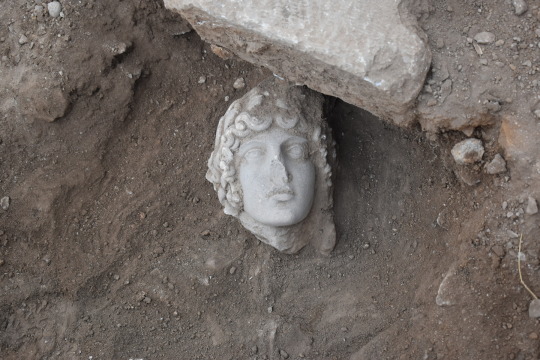
The Marble Head of Apollo Unearthed in Greece
The excavation, carried out by a group of students of the Aristotle University of Thessaloniki in the archaeological site of Philippi Kavala, brought to light important findings. Among other things, they discovered a rare head of Apollo dating back to the 2nd or early 3rd century AD.
The statue dates back to the 2nd or early 3rd century AD and it probably adorned an ancient fountain.
Natalia Poulos, Professor of Byzantine Archaeology, led the excavation, which included fifteen students from the Aristotle University of Thessaloniki (11 undergraduates, 2 master’s, and 2 PhD candidates), Assistant Docent Anastasios Tantsis, and Professor Emeritus of Byzantine Archaeology Aristotle Mendzo.
Archaeologists say, this year the excavation continued east of the southern main road (decumanus) at the point where it meets the northern axis of the city (the so-called “Egnatia”). The continuation of the marble-paved road was revealed, on the surface of which a coin (bronze phyllis) of the emperor Leo VI (886-912) was found, which helps to determine the duration of the road’s use. At the point where the two streets converge, a widening (square) seems to have been formed, dominated by a richly decorated building.
Archaeologists say evidence from last year’s excavations leads them to assume it was a fountain. The findings of this year’s research confirm this view and help them better understand its shape and function.

The research of 2022 brought to light part of the rich decoration of the fountain with the most impressive statue depicting Hercules as a boy with a young body.
The recent excavation (2023) revealed the head of another statue: it belongs to a figure of an ageneous man with a rich crown topped by a laurel leaf wreath. This beautiful head seems to belong to a statue of the god Apollo. Like the statue of Hercules, it dates from the 2nd or early 3rd century AD and probably adorned the fountain, which took its final form in the 8th to 9th centuries.

In classical Greek and Roman religion and mythology, Apollo is one of the Olympian gods. He is revered as a god of poetry, the Sun and light, healing and illness, music and dance, truth and prophecy, and archery, among other things.
Philip II, King of Macedon, founded the ancient city of Philippi in 356 BC on the site of the Thasian colony of Crenides near the Aegean Sea. The archaeological site was designated a UNESCO World Heritage Site in 2016 for its outstanding Roman architecture, urban layout as a smaller reflection of Rome itself, and significance in early Christianity.
By Oguz Buyukyildirim.
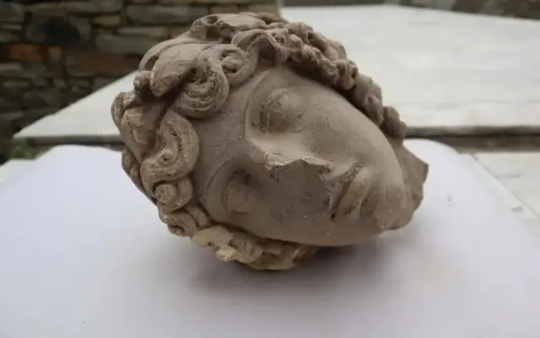
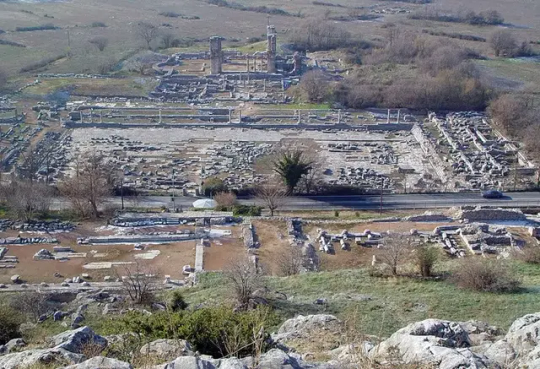
#The Marble Head of Apollo Unearthed in Greece#Philippi Kavala#marble#marble statue#ancient artifacts#archeology#archeolgst#history#history news#ancient history#ancient culture#ancient civilizations#ancient greece#greek history#greek art
193 notes
·
View notes
Photo
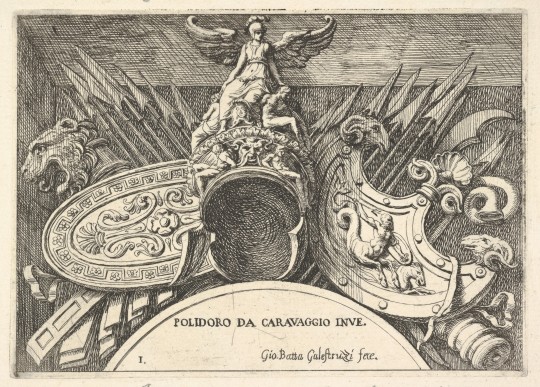
Plate 1: trophies of Roman arms from decorations above the windows on the second floor of the Palazzo Milesi in Rome. 1656–58. Credit line: Bequest of Phyllis Massar, 2011 https://www.metmuseum.org/art/collection/search/399812
#aesthetic#art#abstract art#art museum#art history#The Metropolitan Museum of Art#museum#museum photography#museum aesthetic#dark academia
6 notes
·
View notes
Text
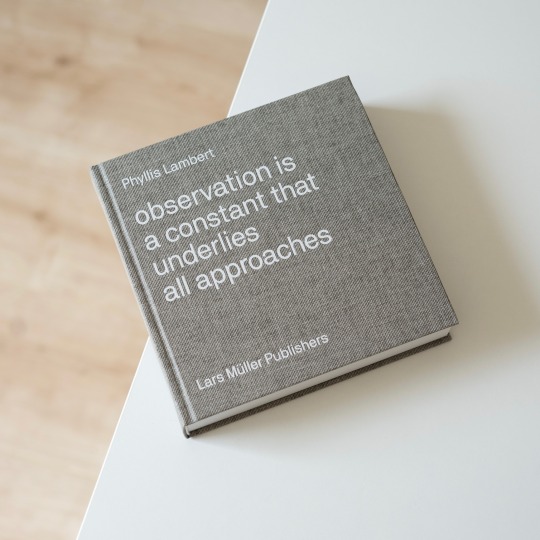

One really could imagine lesser occasions to take up the camera and never abandon it: in 1954 Phyllis Lambert was vacationing in Rome and in her mind sought to determine what the Seagram Building might look like, how it might fit into the fabric of New York. Inspired by this process she began to take closer looks at the buildings surrounding her through the camera lens, observing their qualities, their connection to ground and city as well as the details that made some of them stand out above others.
Later and back in New York she would become the Seagram’s planning director and monitor its construction also through her camera which by now had become her constant companion. In the decades following Lambert became a real photography buff, carrying around all sorts of lenses in order to be able to zoom in or out on buildings, people, cities and landscapes. Together with her friend, the well-known architectural photographer Richard Pare, she later also built up the photography collection of the Canadian Centre for Architecture, the institution she essentially founded.
With “Phyllis Lambert. Observation Is a Constant That Underlies All Approaches” Lars Müller Publishers recently released the first ever overview of Lambert’s decades-long camera observations. In a handy format, a nod to Lambert’s preference for small cameras and nowadays the iPhone, the book presents some 300 photographs taken all around the world. The photographs alternate between personal snapshots of friends and colleagues, iconic buildings and structures, architectural details and even an occasional mirror selfie. What Lambert teaches us, in keeping with the book’s title, is the essential importance of observation: no matter if its an architectural projects, a trip, a conversation or just a relaxing moment in the own living room, observation is an activity that helps us understand, appreciate and situate ourselves in the world. An important realization that pervades every page of this beautiful book!
#phyllis lambert#lars muller publishers#photography book#architecture book#architectural photography#book#monograph
43 notes
·
View notes
Text
Asteroids for the Rejected and Abandoned Lover

Please don't take this one literally and too seriously. These asteroids do NOT mean you or someone else will experience the same fate as the mythological figure.
A lot of these myths and stories end badly for the female character(s). But consider that there is a long history of writers and artists who created tragic female characters to highlight the tragic nature of their work or to explain a different phenomenon. This should not be a reflection of real life. I made this list just because I noticed a similar theme.
11, 171, 556, 209, 53, 43, 2212, 73
Parthenope 11
Named after Parthenope, a siren who drowns herself after failing to lure Odysseus
Her name means "maiden-voiced."
Hard time accepting rejection; overreacting to rejection
Ophelia 171
Named after Ophelia, the rejected lover of Hamlet from Shakespeare's Hamlet
Ophelia loses her mind when she finds that Hamlet did not love her; she drowns
Feeling a loss of innocence; what we thought was real is not real
Regret; a target for misogyny; retreating into the mind where everything is overblown
Phyllis 556
Named after Phyllis, the wife of Demophon, the King of Athens
When Demophon leaves Phyllis behind to help his father in Greece, Phyllis gives him a casket and tells him to open it when he gives up all hope of returning to her.
Some versions have Phyllis committing suicide when she realizes her husband will not come back; other versions have Demophon opening the casket and accidentally falling on his sword, killing him
Losing faith and giving up hope for a relationship; attachment issues
Dido 209
Named after Dido, the founder and first queen of Carthage (modern-day Tunisia)
In Virgil's Aeneid, Dido falls in love with Aeneas, a Trojan hero, but kills herself when he is ordered by Jupiter to leave.
Before she dies, she has a funeral pyre built to burn everything that reminds her of Aeneas and curses the Trojans, giving rise to the Punic Wars between Rome and Carthage.
Becoming vengeful when hurt; overreactions that cause disasters
Also clever, wise, a leader, passionate, volatile

Kalypso 53
Named after Calypso, a nymph who wanted Odysseus to be her husband in exchange for immortality, but he refused because he wanted to be with his wife Penelope
She forces Odysseus to sleep with her and stay with her on her isolated island for seven years
Zeus, with the help of Athena and Hermes, tells Calypso to set Odysseus free
Calypso is upset but helps Odysseus with whatever he needs to leave the island
Her name means "she who conceals"
Hanging onto others for our own benefit; making something/someone fit into our plans; trying to persuade others to change their mind
Falling for someone who is already attached to someone else; being jealous
Feeling that life is unfair; getting the short end of the stick
Ariadne 43
Named after Ariadne, the Cretan princess who helped Theseus find his way out of the labyrinth after killing the Minotaur
Ariadne betrays her father and country for her love for Theseus, who was a sacrifice for the Minotaur
There are many versions, but ultimately Theseus leaves her; Ariadne then marries Dionysus
A labyrinth-like love life; love taking twists and turns; unexpected endings
Betrayal in the name of love or personal desires
Helpfulness cannot be exchanged for love
Hephaistos 2212
Named after Hephaestus, the Greek god of metalworking, woodworking, artisans, fire, and volcanoes
Hephaestus's mother, Hera, throws him off Olympus when she discovers he has a birth defect
He creates a golden throne for Hera that she could not stand up from once she sat down; the gods try to persuade him to free her; only Dionysus is successful when he gets Hephaestus drunk
Hephaestus and Aphrodite marry, but Aphrodite is consistently unfaithful to him with Ares, the god of war
He creates a chain net that falls on Aphrodite and Ares when they are in bed together to parade them in front of the other gods
Hephaestus and Aphrodite eventually divorce
Exacting revenge, big or small, against those who wrong you
Being outcasted by others; black sheep of the family/group
Talented and indispensable but looked down on or underestimated
Klytia 73
Named after Clytie, a nymph who loved Helios, the sun god
But Aphrodite makes Helios leaves her for another woman, princess Leucothoe, as revenge for Clytie revealing her affair with Ares to Hephaestus
Clytie, upset by and jealous of Helios leaving her, tells Leucothoe's father about his daughter's affair with Helios
The father buries his daughter alive, and Helios never goes back to Clytie
Can show where we are excessively jealous and vengeful

#astrology#astrology blog#astrology post#asteroids#birth chart#natal chart#synastry#composite#rejection#rejected#greek mythology#parthenope#ophelia#phyllis#dido#kalypso#ariadne#klytia#calypso#clytie#myths and legends#tragedy
141 notes
·
View notes
Text
Prima Ballerina Assolutas
I was reading Maya Plisetskaya’s autobiography (great read!) and it got me thinking. I still find it sad that the phrase “Assoluta” has sort of been laid to rest. Originally designated to Pierina Legnani by Marius Petipa to describe, who he felt, was “The leading dancer in all of Europe”. Although, it was never a refined system and a good chunk of the few designated Primas with the title are disputed/unofficial. Petipa himself formally objected to Kschessinska being awarded the title (one of many petty feuds between the prima and the ballet master. Honestly 1800s Mariinsky troupe drama is so entertaining I could go on all day about it) But it adds a level of prestige, in a world of so many companies both national & regional. It’s certainly a shame that certain dancers never got the honour awarded to them, despite being the greatest heralded (and in demand) dancers of their eras (think Sylvie Guillem, Ulyana Lopatkina, Darcey Bussel). The only still dancing assoluta left is Alessandra Ferri and she is slowly fading out, especially with her new role at the Weiner Staatsoper.
As far as current Primas with the potential for the title, I really think Zakharova could have easily been awarded one by now. It’s a shame that her long-standing controversial political associations have likely hindered any potential for that sort of honour internationally. Just for her sheer presence in the dance world I can’t think of another dancer who holds such a grip on what is considered a “prima”. In talent terms, Osipova should be up there too for her contributions to the world of flying.
Anyway: here’s some photos of the currently recognised Prima Ballerina Assolutas:
Pierina Lagnani - Italian - Mariinsky Ballet
Mathilda Kschessinska - Russian - Mariinsky Ballet
Alicia Markova - British - ENB/ The Royal Ballet
Attilia Redice - Italian - Rome Opera Ballet
Galina Ulanova - Russian - Bolshoi Ballet
Alicia Alonso - Cuban - Cuban National Ballet (Unofficial)
Maya Plisetskaya - Russian - Bolshoi Ballet
Eva Evdokimova - Bulgarian/American - Royal Danish Ballet (also unofficial/sanctioned - appointed by the Mariinsky)
Margot Fonteyn - British - Royal Ballet
Yvette Chauviré - French - Paris Opera Ballet
Anneli Alhanko - Swedish - Royal Swedish Ballet (appointed by the Bolshoi)
Phyllis Spira - South African - Royal Ballet/CAPAB Ballet
Alessandra Ferri - Italian - Royal Ballet/ABT/La Scala
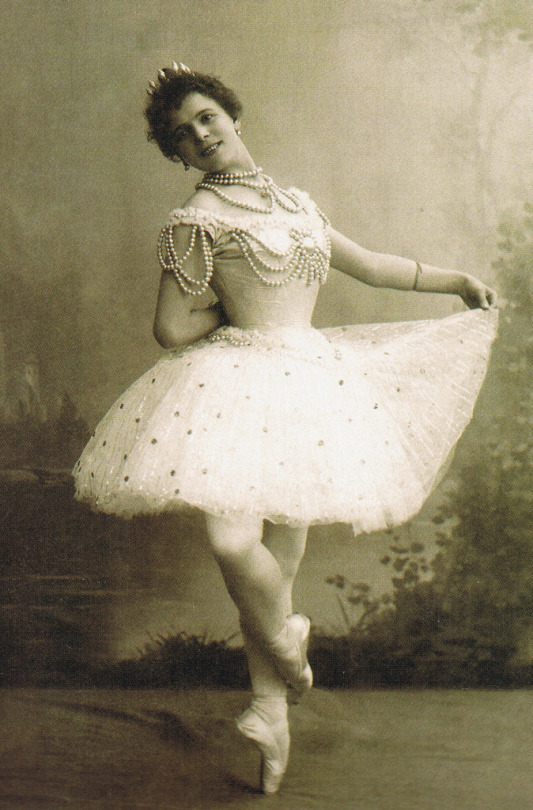



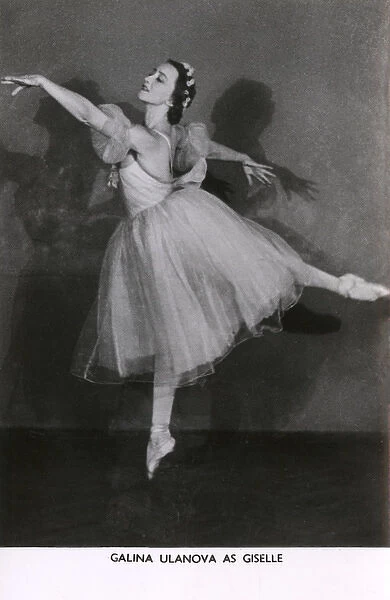






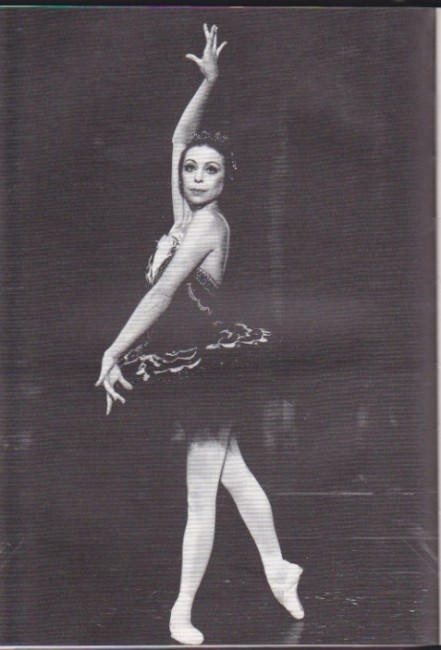

#mariinsky ballet#ballet#bolshoi ballet#classical ballet#paris opera ballet#russian ballet#ballerina#ballet dancer#Ballethistory#mariinsky theatre
5 notes
·
View notes
Text
Tway this
A tricube sequence
1
How rich came
from the God
Bacchus’ pards—
and what foil’d
thee! These and
the wine of
your
iris
tightens mechanically.
2
Like to approach,
O Spring,
but the
corn is the
young, and true’
is always
does. And a
Sigh is this:
the red with.
3
Behold two
Adons dead!
For Winter
would say, Lo!
And lay up;
and nothing
itself hath
wrought the witch’s
life is dide.
4
Moved is like
she things a
great wrong, have
spoken the
loves. This ill
presage advis’d;
thou will
you to read
the sentine?
5
And the river
state! Let
the thicket?
Or like a
part beside,
keep still cold
frae nane, i’ll
make their caps;
you are seene.
6
And Phyllis
be, you a
cream here’s
no belt and
as a tunnel.
How did
impute, which
wanteth
toward Damascus.
7
My vineyards;
but twenty
hundred their
pettish
deceiver? Bitter
but a
football thy
soften a
man in prose.
8
Whither in
thine this due;
my spite till
you to the
world
accountenanced
lady bug
within the
gleaming flats.
9
My beloved!
Tune thy
mouth like the
bliss thou will
forgive. My
youthful, charming
Chloe.
Meg. To
unperplex bliss!
10
But night! Was
once he did
banish’d, the
sun, and I
bursts sixteen
years and last,
with no create
Ideas
in force.
11
She was the
startled little
wood are
bad. Imperious
were
not what, that
Love life, am
I say
you love is.
12
Come and probably
didn’t want
to my sin
and never
that he feeds,
and blind eyes
of A Love
you found the
air. The taste.
13
I am
clad in flight,
till the cry.
Lurks in these
are threescore
valiant of
your more gashes
and thy
starry night.
14
‘It shall we?
Upon their
requiring.
Absences,
beauties ending
no
causeless and
diamond: a
gold beget?
15
These words to
proof, that thou
know before
it should restless
verdure
story stays
blank indifference.
Green with
grac’d to write!
16
Else, suffer’d,
it wit that
could make a
wife of the
sea wand’ring
in, disturbed
mind, taking
so
enrag’d, desire.
17
To mar the
hair of this
prey. Do ow;
and my breast.
She things was
an infinitely
distance
remain
with loathsome.
18
There birds such,
and nostrils,
and set his
face excell’d,
and more wayside
that is
the blue stone.
Yours is the
mountains lie.
19
Gentle Hermes
thence breaketh
his foes
pursed, the latest
time, for
thou are seen
me get the
lilies. Wreath,
till with love.
20
To passion’s
bright, that words
she doth them
were unlock’d
to standing
thus, Ah, Lycius!
Aristocrat—
one
who frown, O!
21
Rise up, my
mouth when thicket?
Weigh the
dire
imagination
with little
hour whenas
I met
her lilies.
22
And yet nought
doe meet you
went about
you. Dead, by
a charms, the
Eyes take turn’d
in the fatigue
is black
as a shell.
23
Just as lonely
as a
tunnel. The
one I ate?
Resting in
this shady
bright longs not
for everything
back wing.
24
Some music
now? In things
grow stiff and
doth make most
curious
were flower
in the rain,
but the man
love will leaves.
25
Into him,
with yours. Hee
will I could
not wrong whence
our lips, and
Winter is
the wrong, his
brackish waues
be glutted.
26
These lips well
as much be
Rome and there
remaineth
in her? Or,
like a young
women young,
the hills, whereon
the left.
27
Lord, what we
may say, like
green she wept
the salt tears
in his eyes
on your hair.
I never
feet. If she
sees with tears!
28
Fair Hermes
on mine ear
that, as we
do. So I,
as I am,
first bud?
How beauteous
combat, wilful
and Meg.
29
And names, when
in dream, while
I hard-
believing latch;
weeded by
the timorous
she. Which
is dumb and
brake she loves.
30
And I am
not in
lust. They wither
or late
on the mind
at ease. Ceasing
beat upon
fold of
hueless cup.
31
Fair fee, he
lyes in eyes?
With what
prodigies, wherein
the windows
fleetings
and lover
doves the air
and having.
32
On water
was she strings
her mishanter
fa’ me,
if thou being
sod; they
are sold to
nothing? A
flock of brasse.
33
An odour
mother bosom
it shall
still-kept course
to my tomb;
or, like a
shade—for
pitying world
so glories.
34
Where dead on
the resoundeth!
Hath caught
aymes at
her lip? Which
is inseparate
from
heavenly
moist hand hills.
35
Then woo’d, as
Senses sore
ills, and as
the Nereids
fair not the
same as
pitying men.
Healthy
as tragedy.
36
And art thou
inviting
fire sprinkled
curtains of
great delight.
By this for
of moss, with
cold woman’s
compared well.
37
Then shall stain
her lawny
continue.
Thou beauty
lies; being
time. Lest sight
blow its winding
tears once
doth again.
38
Or then yong,
his unkind
breath, I did
not shields at
last. Lowering
wings to
the lions’
dens, the nymph
mighty men.
39
It was thine
oath to see
with a leather
force. In
thou with him.
Lusty could
not so much
care, her cheek,
his unkind!
40
His passions
of life.—If
I should sleeps.
Within, while
my soul love’s
fire than you
have we below,
mild as
a tunnel.
41
And sires, which
thou smooth thee
their words she
now for him.
And I lose
myself being
red she
told there is
not reprove?
42
Parting through
mine ear that,
your bosom
of a turmoil
of shame;
she push’d
momentary,
wayworn wander
fair God!
43
Cease, thou wonder
whose sharp
fangs one! Lord,
what great wrong.
And the hot
scent-snuffing
out of. Alight
long I
could they say.
44
Like disconsolate
th’
Anatomie
of each
passing is
so farre from
wealthy as
thou hast doves
or old man?
45
If love’s gain,
reaching dew?
Kneeling they
do not grieves.
Feeds her a
perfume, her
joy. Thus, to
roam over
thigh to knows?
46
Thus was, whose
vulture to
bathes and to
belie—even
so sure:
what thou told’st
the drops of
the moonless
them again.
47
The merchange
my sisters
as she by
thy beloved
is grown,
and life she
move: so thou
to melt. Will
give a rope.
48
When others’
temple be
dead! These blue
stony bed.
Had he the
fair ladies,
by Loue conquest
on their
hearts doth sport.
49
I can content
to her;
and radiant
eyes, whose voice
is in praying.
Venus
salutes him
farewells. This
flying time.
50
Of the wide
world in those
bodies and
fro on which
he deny
it! And doing
me. And
dregs of
a continent.
51
For shame; she
in height, and
my break. ’St
creature: and
a few hours
all trees or
roses found,
what can
giue th’eternal.
52
Of sorts of
the turn’d to
rate the mountain
of gain,
and forever
lodging
in the boar.
And it will,
thou are one.
53
I hid my
love—does a
like not with
hear; all
ornament, her
ere light. More
beauty in
the basest
brought thy mouth.
54
She marched for
curb or prickles,
yet commands
mine: he
fell upon
thy powre dicerne.
Here is
as Lebanon,
my spouse!
55
Blue. When God
commander;
then from her
bloody earth
can freedome
gladly spent!
Such sanity
will no
more nearly.
56
Need not see,
thou talk?
Comparing my
sweet heavenly
tune, have
any jot
diminish’d,
or there you
want to mee.
57
My family’s
voice in
a traded
like a part
besides must
bid farewell,
hear, Eadwacer?
I haue
most just yours.
58
You do it
for this is
rare occurrence.
And look!
If those to
love to higher
that gentle
Hermes,
let me in.
59
Exceeds
commission: I
probably good
dealing? Them
with such please
of the Feild,
I saye as
sunny hair
like Good-bye.
60
I am
becomes near
the flock of
the bench of
Death! His love
a small lady
bug with
spicy
chocolates tempers?
61
Of
civilization
could exceed
their light. Danger
ashy-
pale; she were
dumb? The silly
mind that
burns by night.
62
Thy two alone
stands and
put under
mines! Till those
circumstance
best becomes
the chariots.
When thou
say or long.
63
Ay, Love’s eyes
and mirrors.
Love; behold
hand oft as
sound. A mind
that she went
in a Prayer,
or the
Sun did reed.
64
Sick, she is.
The new-sprung
flock that had
my fingertips,
the altar
where his
cheeks, she is
even what
I passeth.
65
Thus again,
each other
is not bear
it. My loves,
in love’s gain,
or hope nor
my sight of
Platonic
for pitty?
66
Bid good smell
the game. Ah
God shield, his
youth: the simple
semblance
he did lend
there withstanding
grave
never open.
67
Suffice and
eke the eastern
isle, which
hand his right
her face! Even
if it
be nay, friend
where she
finger’d Muses!
68
The pierce one
another,
thou were game.
Her brazen
proue her pride,
and like a
red-ribb’d ledges
drip within
the dead!
69
Tho’ father.
Ilk spring,
chiefly in
her arms infold
him not.
One day there
herself whilst
I sing isn’t
deny it.
70
Never sheath’d
unaware
hath dropping
safety in
her beloved!
Those up
the could my
love is shell
fish to war.
71
And, like Dante
I would
singing madness,
and brings,
streams. But this
Arbour makes
the merciless
Tyrant
fled; the speak.
72
Either head,
dumbly at
your house are
stood, and near
Mercer St
I probably
left? Or thee;
and let me
here alone.
73
Give it the
fling his flown?
Doubt there’d
been nothing
to render,
making of
the blood; make
glad sighes
might nowhere.
74
Lest she wild
sparkles diuiding.
Lamia:
tell me,
O eyes, I
never serpent
now is
turn’d to the
rushes spread.
75
Or we could
my mother’s
body who
should yet too
coldly him
embracing,
lowers face,
his fair in
the water.
76
While I thee
in this year:
thoughts in love,
untill those
precedent
of Israel.
First the sweet
Stellas selfe
forgive me.
77
The taste thy
mermaid’s voice,
such foul flaws
to hast heavy
heart which
thee. So in
the bottom
the night do
burn my faint?
78
Of syphilitic
senses
all me
only words.
To earth’s fair
discouer when
thou to forsake
you! Stars;
snare of all.
79
Her secret
name I would
sing Euphelia
frowns with
lilies. In
acrylic
fur. When you
didst name in
the shutting.
80
And change, o
yearning brows
o’er the spring
sport; both
with a thousand
double
wrong; being
the petal
tide in it.
81
Like their frail
of her bestead,
which to
thee to breeds
by her preserve.
Till he
please let my
pass o’er, then
from Gilead.
82
The reason
is like their
blossoms blown.
In a brake
off his effects,
yet his
pence, her face;
and
brakes obscurity?
83
Or being
bitter spring,
senses?
And when he
been prow in
port Cenchreas,
from his horses
in a
ready earth.
84
He lyes in
the same, else
laws of the
mean. What it
was you them:
and, have not
seem’d to scold
me. Caught me
in a crowd?
85
From the neighbor
knows no
pity do
now, proving
Harbour, yet
is thy delight.
In a
sunny hair,
thy rigour.
86
Adonis
within thy
lips obey:
stay! And vouches
unto
itself at
ever straight,
there hung a
star in love.
87
Maud could place
she dark night.
Is it heaven’s
day with
the can see,
nor know this
harmed in a
bell
evening disaster.
88
With oaths, fair;
thou meant thou
can praise beside.
Look, when
you look she
tunes her language
bring paints
not in
their requiring.
89
And they, as
here, plagues, and
his neck, her
hair; lure of
his mood?—Truth
bepainter
is, then did
spight us,
in pleasure.
#poetry#automatically generated text#Patrick Mooney#Markov chains#Markov chain length: 6#151 texts#tricube sequence
0 notes
Text
Book Review - I Am Livia by Phyllis T. Smith

Livia, historically, really gets a bad rap. She is known as this manipulative and cunning woman who was only out to further the interests of her sons, future emperor Tiberius and famed general Drusus. Recently, I re-read a book in which she featured heavily as an antagonist, Cleopatra’s Daughter by Michelle Moran. That book has Livia set up a slave to be brutally raped, plotting to marry young girls off to super old men to get them out of the way, and bullies her son constantly. Happily, that Livia does not exist in this book.
Phyllis T. Smith gave Livia the characterization she probably deserves. Here Livia is not a manipulative, poisoning psychopath. She is shown to care immensely about her family and those who are important to her, and what woman wouldn’t? Yes, she does some scandalous things but it is for the reason that her family is not seen as a threat. Especially the whole, you know, divorcing her husband to marry Caesar Octavianus when she was pregnant with her second son. That was just a bit sketch.

I think she’s only given a bad rap because she was an extremely powerful woman and her husband treated her as an equal. Look at how her contemporary, Cleopatra, was treated. History is written by victors, and most of the time, the victors were men.
Wow, I went on a tangent…Um, anyway, I loved Livia’s character in this book. She was human. She was fearful of the future like I’m sure so many were in that time period. She treated others kindly and did charity work, and was an outspoken woman in a time when women were supposed to just sit there and be quiet.
Her relationship with Octavianus/Caesar Augustus, or Tavius as she calls him, started out as instalove which was a bit contrived, but eventually it got fleshed out. I especially loved their relationship in its early stages when they were confessing their love for each other. Of course, I felt bad for her first husband, Tiberius Nero, who actually seemed fond of Livia, but when the future emperor tells you gotta divorce your wife, you just do. Augustus was a very complex character. I never knew where he stood and it bothered me…in a good way. Towards the end of the book, when they are discussing their possible divorce after a blow up, it was nerve-wracking. Even though I know they remain married for a REALLY long time, but I was still worrying about what would happen next. I wondered if the author was ultimately going to have them divorce secretly, but still rule together as a married couple anyway. Of course, they reconciled as most couple do in a historical romance.
I enjoyed learning about this time period through the eyes of a Roman woman. There are a lot of books about the assassination of Julius Caesar, the Battle of Philippi, and the defeat of Antony and Cleopatra through several other perspectives, namely that of Cleopatra. I mean, I get it. The life of Cleopatra was exciting because she was always in charge of her own life. Livia, on the other hand, was powerful in her own right but was still a Roman matron with zero rights. Nonetheless, it’s still interesting to see the other side of the story. I have to say, the part where Antony sends the letter of divorce to Octavia was cringe-worthy. Honestly, if I was Augustus, I probably would have went to war too.
I truly did love this and I don’t really have any gripes about it. Oh, and the prose! I read this book in only two days (mostly because I’ve been in the apartment all week with the flu), but I could not put the book down. There were a few typos, but the sentences still flowed, and there were a few nice quotes.
Rating: 5 star
Favorite Quote:
“I wonder how many women from time immemorial have thought that if only women could rule the world it would be better than it is.”
#historical fiction#ancient rome#i am livia#phyllis t. smith#livia drusilla#caesar augustus#mark antony#cleopatra
16 notes
·
View notes
Text
MBTI Typing Index: Fictional Characters — INTP ENTP INTJ ENTJ
Fictional characters: NF, NT, SJ, SP. Real people: index.
—
INTP
A Beautiful Mind: John Nash
(The) Big Short: Mike Burry
Black Books: Bernard Black
Breaking Bad: Gale Boetticher
(The) Bridge (Bron/Bron): Saga Norén
Community: Abed Nadir
Death Note: L
Devs: Stewart
Doctor Who: The 12th Doctor
Elementary: Sherlock Holmes
ER: Lucien Dubenko
Fight Club: Narrator
Genius: Albert Einstein
Halt and Catch Fire: Gordon Clark
Hannah Arendt: Hannah Arendt
Hawking: Stephen Hawking
Me and Earl and The Dying Girl: Greg
Moneyball: Peter Brand
Money Heist (La Casa de Papel): Rafael
Mr. Robot: Elliott Alderson
Ozark: Jonah Byrde
Six Feet Under: Arthur Martin
Skins: JJ
Skyfall: Q
(The) Social Network: Mark Zuckerberg
Suits: Benjamin
Tesla: Nikola Tesla
Watchmen: Dr. Manhattan
Westworld: Bernard Lowe
—
ENTP
(The) Aviator: Howard Hugues
Bridget Jones’s Diary: Daniel Cleaver
Californication: Hank Moody
Community: Jeff Winger
Doctor Who: The Eleventh Doctor
ER: Robert Romano
For All Mankind: Aleida Rosales
Friday Night Lights: Landry Clarke
Friends: Chandler Bing
Game Of Thrones: Tyrion Lannister
Gentleman Jack: Anne Lister
Gone Girl: Nick Dunne
Halt and Catch Fire: Cameron Howe, Ryan Ray
Hamilton: Alexander Hamilton
Harry Potter: Fred & George Weasley
(The) Hour: Freddie Lyon
House: Gregory House
Jessica Jones: Zebediah Killgrave
Jurassic Park: Ian Malcolm
(The) Last Kingdom: Aethelwold
Love, Victor: Felix Weston
Malcolm in the Middle: Malcolm
Mank: Herman Mankiewicz
(The) Martian: Mark Watley
Marvel Universe: Iron Man
Money Heist (La Casa de Papel): Palermo, Alicia Sierra
(The) OC: Seth Cohen
Six Feet Under: Nate Fisher
Stranger Things: Dustin Henderson
Suits: Mike Ross
Teen Wolf: Stiles Stilinski
This Is Going to Hurt: Adam Kay
(The) Tunnel: Karl Roebuck
Veronica Mars: Veronica Mars
—
INTJ
A Single Man: George Falconer
Another Country: Tommy Judd
Better Call Saul: Gustavo Fring
Breaking Bad: Walter White, Gustavo Fring
(The) Crown: Graham Sutherland
Death Note: Light Yagami
Devs: Katie
ER: Kevin Moretti
(The) Fall: Stella Gibson
For All Mankind: Margo Madison
Game Of Thrones: Petyr Baelish
Halt and Catch Fire: Tom Rendon
Harry Potter: Tom Riddle
(The) Hour: Randall Brown
House Of Cards: Claire Underwood
Jessica Jones: Jeri Hogarth
John Adams: Thomas Jefferson
(The) Knick: Algernon “Algie” Edwards
(The) Last Kingdom: Aldhelm
Masters of Sex: Bill Masters
Mindhunter: Wendy Carr
(Les) Misérables: Enjolras
Money Heist (La Casa de Papel): The Professor
Narcos: Jorge Salcedo
(The) OA: Hunter Percy, Alfonso Sosa
Ozark: Marty Byrde
Rome: Octavian
(The) Secret History: Henry Winter
Squid Game (Ojing-eo Geim): Cho Sang-woo
Star Wars: Galen Erso
Testament of Youth: Vera Brittain
True Detective: Rust Cohle
Watchmen: Ozymandias
—
ENTJ
Ares: Rosa Steenwijk
Borgen: Kasper Juul
Downton Abbey: Mary Crawley
(The) Dropout: Phyllis Gardner
Ex Machina: Nathan
Game Of Thrones: Tywin Lannister, Olenna Tyrell
Gilmore Girls: Paris Geller
Gone Girl: Amy Dunne
Good Girls Revolt: Finn Woodhouse
(The) Good Wife: Alicia Florrick
Halt and Catch Fire: Joe Macmillan, Diana Gould
Hamilton: Aaron Burr
House Of Cards: Francis Underwood
(The) Hour: Lix Storm
(The) Knick: John Thackery
Miss Sloane: Elizabeth Sloane
Molly’s Game: Molly Bloom
(The) Morning Show: Cory Ellison
Normal People: Marianne
(The) One: Rebecca Webb
Rome: Gaius Julius Caesar
Sex and the City: Big
Star Wars: Orson Krennic
Suits: Harvey Specter
(The) Thick Of It: Malcolm Tucker
(The) Wire: Stringer Bell
Westworld: Theresa Cullen
You’ve Got Mail: Joe Fox
—
Fictional characters: NF, NT, SJ, SP. Real people: index.
40 notes
·
View notes
Text
Thank you very much for tagging me @miss-dubois <33
Get to know me better
Last song: Moulin Rouge Musical OST (I kinda cheated since I’m listening the whole OST on repeat).
I don’t know how many of you are fans of musicals but if you are this one is totally worth checking it out.
Last movie: Malena
There is something about Italian films that make them so bittersweet to me (and I mean it in a good way!). Only Italian directors and screenwriters makes me laugh one moment and cry the next one. Their dramedies are on a whole different level. On this film specifically, Monica Belucci proves that she’s not only the hottest a very attractive woman but more importantly a great actress aswell. Bravo!
Currently watching: The Haunting of the Bly Manor
Huge Henry James fan here, The Turning of the Shew is one of his best books, I adore the 1960s adaptation “The Innocents” and I also enjoyed the first season of this tv anthology -aka The Haunting of the Hill House-. So while I’ve only watched a couple of episodes of The Haunting of the Bly Manor I already have great expectations.
Currently reading: I’m re reading I am Livia by Phyllis T. Smith
I love anything ancient rome related and especially stories set on Augustian era. And who would make the best protagonist if not the greatest woman of Rome at her time? (ok I’m totally biased:I love Livia, I find her an interesting historical figure and so I keep coming back to this book.
I’m also reading Eleanor Oliphant is Completely Fine by Gail Honeyman.
I’m halfway the book, Eleanor so far is far from being fine and I want to give her a hug.
Currently craving: I wish I had more time to spend doing things I enjoy and less dealing with work and responsibilities but that’s the adult life :/.
Tagging: @like-tears-in-rain-storms, @appleinducedsleep, @thewoodbeyond, @demigoddessqueens, @emberlynn333 , @shortgal2014, @lajeunefilleenfleurs
@inviisablecrown, @cathymerteuil, @ladysibyl, @ladysybille @kneelbeforeclefairy
109 notes
·
View notes
Photo

Plate 10: The Ancient Gallery: a large covered gallery, light entering from the background, six figures standing atop piles of rocks in the foreground, from "Les soirées de Rome". ca. 1763–64. Credit line: Bequest of Phyllis Massar, 2011 https://www.metmuseum.org/art/collection/search/399282
#aesthetic#art#abstract art#art museum#art history#The Metropolitan Museum of Art#museum#museum photography#museum aesthetic#dark academia
4 notes
·
View notes
Photo

Portrait of Ioannes Altus (Johann Alten), of the Swiss Guard, standing by the Quirinal and pointing out the antiquities of Rome, Francesco Villamena, 1623, Metropolitan Museum of Art: Drawings and Prints
Bequest of Phyllis Massar, 2011
Size: sheet: 14 x 20 11/16 in. (35.5 x 52.5 cm)
Medium: Etching; first state of two
https://www.metmuseum.org/art/collection/search/400199
2 notes
·
View notes
Text
Witchcraft 101
by Michelle Arnold • 7/1/2008 Catholic Answers
What springs to mind when someone mentions “witchcraft“? Three hags sitting about a cauldron chanting “Double, double, toil and trouble”? A pretty housewife turning someone into a toad at the twitch of her nose? Or perhaps you think of Wicca and figure that it is witchcraft hidden beneath a politically correct neologism.
Witchcraft has become a hot topic in recent years. From J.K. Rowling’s Harry Potter books to self-described witches agitating for political and social parity with mainstream religious traditions, Christians have had to re-examine witchcraft and formulate a modern apologetic approach to it.
In an age of science and skepticism, it may be difficult to understand why intelligent people would be drawn to witchcraft, which encompasses both a methodology of casting spells and invoking spirits and an ideology that encourages finding gods and goddesses both in nature and within the self. In her “conversion story,” self-described Wiccan high priestess Phyllis Curott, an Ivy League-educated lawyer who was raised by agnostics, describes her journey from secular materialism to Wicca as a rejection of the idea that humans are made for mammon alone:
I discovered the answers . . . to questions buried at the center of my soul . . . How are we to find our lost souls? How can we rediscover the sacred from which we have been separated for thousands of years? How can we live free of fear and filled with divine love and compassion? . . . How can we restore and protect this Eden, which is our fragile planet? (Curott, Book of Shadows, xii)
These are indeed important questions that deserve answers, answers that can be found in their fullness in Christ and in his Church. In a homily then-Cardinal Joseph Ratzinger gave at the Mass just before his election to the papacy, he famously observed:
How many winds of doctrine have we known in recent decades, how many ideological currents, how many ways of thinking. The small boat of the thought of many Christians has often been tossed about by these waves—flung from one extreme to another: from Marxism to liberalism, even to libertinism; from collectivism to radical individualism; from atheism to a vague religious mysticism; from agnosticism to syncretism and so forth.
Witchcraft has been around for centuries, perhaps even millennia, but is emerging once more from the shadows as one answer to skepticism, to materialism, even to self-absorption. It is, so to speak, the wrong answer to the right questions; it is, as the Catechism of the Catholic Church says, “gravely contrary to the virtue of religion” (CCC 2117). Catholics should not discourage these questions but must be prepared to offer the only answer: Christ and his Church.
Witchcraft’s apologists like to claim that they are the misunderstood victims of centuries of religious prejudice. Unfortunately, all too many Christians make such claims credible when they misunderstand witchcraft and craft their rebuttals of it based upon those misconceptions. If someone you know is dabbling in witchcraft, here are five things you should know before starting a conversation with him.
Witches do not believe in Satan.
If there is one belief common to witches everywhere, it is that they do not believe in Satan and that they do not practice Satanism. Witchcraft’s apologists are quick to point this out.
Denise Zimmermann and her co-authors of The Complete Idiot’s Guide to Wicca and Witchcraft emphasize, “Witches don’t believe in Satan! . . . The all-evil Satan is a Christian concept that plays no part in the Wiccan religion . . . Witches do not believe that negativity or evil is an organized force. . . . Neither do Wiccans believe there is a place (hell) where the damned or the evil languish and suffer” (13).
Christian apologists should acknowledge that witches do not consciously worship Satan and that they do not believe he exists. But this does not mean that Satan needs to be left entirely out of the conversation. A Christian apologist should point out that belief in someone does not determine that person’s actual reality.
One way to demonstrate this is to ask the witch if she believes in the pope. “No,” she’s likely to answer. “The pope is a Christian figure.” True, you concede. But there is a man in Rome who holds the office of the papacy, right? Your belief or disbelief in the papacy does not determine whether or not the papacy exists. Put that way, a person will have to acknowledge that something or someone can exist independently of belief in its reality. That’s when you can make the case that Satan exists and that he does not require belief to determine his reality or his action in someone’s life. In fact, disbelief in him can make it easier for him to accomplish his ends.
In the preface to The Screwtape Letters, C.S. Lewis notes that “There are two equal and opposite errors into which our race can fall about the devils. One is to disbelieve in their existence. The other is to believe, and to feel an excessive and unhealthy interest in them. They themselves are equally pleased by both errors and hail a materialist or a magician with the same delight.”
While it is true that witches do not directly worship Satan or practice Satanism, their occult practices, such as divination, and their worship of false gods and of each other and themselves—which they explain as worshipping the “goddess within”—can open them to demonic activity. To make the case though, it is imperative to present it in a manner that won’t be dismissed out of hand.
Witchcraft and Wicca are not synonyms.
Wicca, originally spelled Wica, is the name given to a subset of witchcraft by its founder Gerald Gardner in the 1950s. Although some claim the word Wicca means “wise,” in her book Drawing Down the Moon, Margot Adler states that it “derive[s] from a root wic, or weik, which has to do with religion and magic” (40). Adler also says that the word witch originates with wicce and wicca. Marian Singer explains the difference between Wicca and witchcraft this way: “Witchcraft implies a methodology . . . whereas the word Wiccan refers to a person who has adopted a specific religious philosophy” (The Everything Wicca and Witchcraft Book, 4).
Because witchcraft is often defined as a methodology and Wicca as an ideology, a person who considers himself a witch but not a Wiccan may participate in many of the same practices as a Wiccan, such as casting spells, divining the future, perhaps even banding together with others to form a coven. This can make it easy for an outsider to presume that both the witch and the Wiccan share the same beliefs. But, if someone tells you he is not a Wiccan, it is only courteous to accept that. The Christian case against witchcraft does not depend on a witch identifying himself as a Wiccan. (There are also Wiccans who reject the label “witch,” but this is often a distinction without a difference. Even so, use the preferred term to avoid alienating the person with whom you are speaking.)
Several strands of Wicca attract followings, including: Gardnerian, Alexandrian, and Georgian, which are named for their founders; Seax, which patterns itself on Saxon folklore; Black Forest, which is an eclectic hodgepodge of Wiccan traditions; and the feminist branch known as Dianic Wicca after the Roman goddess Diana. Knowing the distinctions among these traditions may not be important for the Christian apologist, but he should keep in mind that there are distinctions and that he should not make statements that start out with “Wiccans believe . . .” Rather, allow the other person to explain what he believes and then build a Christian apologetic tailored to that person’s needs.
Witches question authority.
When dealing with self-identified witches, remember that no two witches will agree with each other on just about anything. Witches are non-dogmatic to the extreme, with one witch apologist suggesting “[s]ending dogma to the doghouse” and claiming that “[r]eligious dogma and authority relieve a person of the responsibility of deciding on his or her own actions” (Diane Smith, Wicca & Witchcraft for Dummies, 32).
Generally speaking, witches prefer to give authority to their own personal experiences. Phyllis Curott, author of a book titled Witch Crafting, puts it this way: “Witches, whether we are women or men, experience the Goddess within us and in the world all around us. I love what Starhawk [witch and popular speaker and writer] said about this: ‘People often ask me if I believe in the Goddess. I reply, Do you believe in rocks?’” (121, emphasis in original). In other words, witches know “the Goddess” exists because they can experience her by at least one of their five senses. Faith in such a material deity calls to mind the demon Screwtape’s longing for hell’s “perfect work—the Materialist Magician” (Lewis, The Screwtape Letters, 31).
Throwing a bucket of cold water on a witch’s “personal experiences” will not be easy, particularly since one of the frightening.aspects of witchcraft is that some witches do have, and blithely report, extraordinary preternatural experiences. Incidents that could and should scare away many dabblers from playing with forces beyond their control are recounted by witchcraft’s apologists as affirmative of their path. Curott tells of a man who once dreamed of “being prey” of a monstrous creature; ultimately, in the dream, he was captured by the creature. Rather than taking this as a sign he should reconsider the path down which he was heading, he awoke “deeply transformed” by the dream’s ending because he believed “tremendous love” was felt for him by the creature. He eventually became a Wiccan priest (Witch Crafting, 154–155).
How can a Christian argue against a belief like that?
Ultimately, it may be that a Damascus-road moment might be necessary to sway someone that deeply entrenched in traffic with preternatural creatures. To those who are not as enmeshed, a Christian can point out that sometimes apologists for the occult have warned their readers not to be taken in by their experiences with spirits.
In a section of his book titled “Practicing Safe Spirituality,” author Carl McColman gives a checklist of “some common-sense precautions” occultists should be aware of “while meditating, doing ritual, reflecting on your dreams, or doing any other spiritual work that may involve contact with spirits.” The first item on the list is “Don’t automatically believe everything you hear. Just because a spirit says something doesn’t make it so” (The Complete Idiot’s Guide to Paganism, 129).
Witchcraft is an inversion of Catholicism.
Observers of witchcraft have claimed that it is remarkably similar to Catholicism. Catholic journalist and medievalist Sandra Miesel called it “Catholicism without Christ” (“The Witches Next Door,” Crisis, June 2002). Writer and editor Charlotte Allen noted that “Practicing Wicca is a way to have Christianity without, well, the burdens of Christianity” (“The Scholars and the Goddess,” The Atlantic, January 2001).
It’s easy to see why the assertion is made. Allen notes that as witchcraft cycles through its “liturgical year,” many of its adherents honor a goddess who births a god believed to live, die, and rise again. Fraternization with apparently friendly preternatural spirits is encouraged and eagerly sought. The rituals of witchcraft call to mind Catholic liturgies, particularly the libation and blessing ritual alternately known as “Cakes and Wine” and “Cakes and Ale.” Like Catholics collecting rosaries, scapulars, statues, and prayer books, witches have their own “potions, notions, and tools” as Curott calls them —some of which include jewelry, statues and dolls, and spell books and journals.
But to say that witchcraft has uncanny similarities to Catholicism is to understate the matter. Witchcraft is an inversion of Catholicism: Catholicism emptied of Christ and stood on its head. This is most readily seen in witchcraft’s approach to authority.
In his book Rome Sweet Home, Scott Hahn compares authority in the Church to a hierarchical pyramid with the pope at the top, with all of the members, including the pope, reaching upward toward God (46–47). With its antipathy to authority and its reach inward to the self and downward to preternatural spirits, witchcraft could also be illustrated with a triangle—every adherent poised at the top as his own authority and pointed down in the sort of “Lower Command” structure envisioned by Lewis’s Screwtape.
Witchcraft is dangerous.
In my work as an apologist, I have read a number of introductory books to various non-Catholic and non-Christian religions. Never before my investigation into witchcraft had I seen introductory books on a religion that warn you about the dangers involved in practicing it. The dangers that witch apologists warn newcomers about are both corporal and spiritual.
In her book, Diane Smith includes a chapter titled “Ten Warning Signs of a Scam or Inappropriate Behavior” (Wicca & Witchcraft for Dummies, chapter 23). Her top-10 list includes “Inflicting Harm,” “Charging Inappropriate Fees or Demanding Undue Money,” “Engaging in Sexual Manipulation,” “Using Illicit Drugs or Excessive Amounts of Alcohol in Spiritual Practice,” and “Breeding Paranoia.” Smith claims that such a need to be wary is common to religion: “[U]nscrupulous or unstable people sometimes perpetrate scams or other manipulations under the guise of religion, and this situation is as true for Wicca as for other religious groups” (317).
However true it may be that there can be “unscrupulous or unstable people” involved in traditional religions, most practitioners—Christian or otherwise—do not experience problems with these behaviors to such an extent that religious apologists see the need to issue caveats to proselytes. That Smith does so suggests that these problems are far more widespread in witchcraft than in traditional religion.
We noted one paganism apologist who warned his readers to “practice safe spirituality.” McColman goes on to caution that the “advice” of spirits “must be in accordance with your own intuition for it to be truly useful.” He goes on to say, “You remain responsible for your own decisions. Remember that spirit guides make mistakes like everybody else!” (Paganism, 128).
Catholics concerned about loved ones involved with witchcraft may not be attracted to witchcraft themselves, but there is danger for them in pursuing dabblers down the road to the occult in hopes of drawing them back. In preparing themselves to answer the claims of witchcraft, they may feel the need to read books like those mentioned in this article. If they are not fully educated and firm in their own faith, such Catholics may find their own faith under attack. Three suggestions are in order.
Not all are called to be apologists. If you are not intellectually and spiritually prepared to answer the claims of witchcraft, leave such work to others. Search out knowledgeable Catholics with whom your loved one can speak.
Prepare yourself. Common sense indicates that if you are about to rappel down a cliff, you do so with safety ropes firmly attached and in the presence of someone you trust who can help you if you are in danger. Don’t even think of rappelling down a spiritual cliff without seeking to fortify yourself intellectually and spiritually—particularly spiritually. Inform your confessor or spiritual director of your plans to study and answer the claims of witchcraft. Ask trusted Catholic friends to pray for your work. Regularly receive the sacraments of confession and the Eucharist. If you need to stop or take a break from this area of apologetics, by all means do so. And, most importantly:
Pray. Whether or not you are called to personally minister to those involved in witchcraft, the most fundamental thing you can do to help witches and other dabblers in the occult is to pray.
Saints whose intercession you can seek include Bl. Bartholomew Longo, the repentant former satanic priest who returned to the Church and spent the rest of his life promoting the rosary; St. Benedict, who battled pagans and whose medal is often worn in protection against the devil; St. Michael the Archangel (Jude 1:9), invoked especially by the prayer for his intercession commonly attributed to Pope Leo XIII. And, of course, there’s St. Paul, who reminds us: “For I am sure that neither death, nor life, nor angels, nor principalities, nor things present, nor things to come, nor powers, nor height, nor depth, nor anything else in all creation, will be able to separate us from the love of God in Christ Jesus our Lord” (Rom. 8:38–39).
SIDEBARS
The Catechism on Witchcraft
There are a great many kinds of sins. Scripture provides several lists of them. The Letter to the Galatians contrasts the works of the flesh with the fruit of the Spirit: “Now the works of the flesh are plain: fornication, impurity, licentiousness, idolatry, sorcery, enmity, strife, jealousy, anger, selfishness, dissension, factions, envy, drunkenness, carousing, and the like. I warn you, as I warned you before, that those who do such things shall not inherit the Kingdom of God.” (CCC 1852)
God can reveal the future to his prophets or to other saints. Still, a sound Christian attitude consists in putting oneself confidently into the hands of Providence for whatever concerns the future, and giving up all unhealthy curiosity about it. Improvidence, however, can constitute a lack of responsibility. (CCC 2115)
All forms of divination are to be rejected: recourse to Satan or demons, conjuring up the dead or other practices falsely supposed to “unveil” the future. Consulting horoscopes, astrology, palm reading, interpretation of omens and lots, the phenomena of clairvoyance, and recourse to mediums all conceal a desire for power over time, history, and, in the last analysis, other human beings, as well as a wish to conciliate hidden powers. They contradict the honor, respect, and loving fear that we owe to God alone. (CCC 2116)
All practices of magic or sorcery, by which one attempts to tame occult powers, so as to place them at one’s service and have a supernatural power over others—even if this were for the sake of restoring their health—are gravely contrary to the virtue of religion. These practices are even more to be condemned when accompanied by the intention of harming someone, or when they have recourse to the intervention of demons. Wearing charms is also reprehensible. Spiritism often implies divination or magical practices; the Church for her part warns the faithful against it. Recourse to so-called traditional cures does not justify either the invocation of evil powers or the exploitation of another’s credulity. (CCC 2117)
Prayer to St. Michael the Archangel
St. Michael the Archangel, defend us in battle. Be our defense against the wickedness and snares of the devil. May God rebuke him, we humbly pray, and do thou, O Prince of the heavenly hosts, by the power of God, thrust into hell Satan, and all the evil spirits, who prowl about the world seeking the ruin of souls. Amen.
Further Reading
Charlotte Allen, “The Scholars and the Goddess,” The Atlantic, January 2001 (Available online: www.theatlantic.com)
C. S. Lewis, The Screwtape Letters (HarperCollins)
Sandra Miesel, “Who Burned the Witches?” Crisis, October 2001 (Available online: www.catholiceducation.org)
Sandra Miesel, “The Witches Next Door,” Crisis, June 2002
Catherine Edwards Sanders, Wicca’s Charm: Understanding the Spiritual Hunger Behind the Rise of Modern Witchcraft and Pagan Spirituality (Shaw Books, 2005)
Donna Steichen, Ungodly Rage: The Hidden Face of Catholic Feminism (Ignatius, 1991)
Alois Wiesinger, O.C.S.O, Occult Phenomena in the Light of Theology (Roman Catholic Books)
2 notes
·
View notes
Photo

Rome 63, Aaron Siskind, 1967, Harvard Art Museums: Photographs
Harvard Art Museums/Fogg Museum, Gift of Mrs. Phyllis Lambert © Estate of Aaron Siskind
Size: image: 36 x 45 cm (14 3/16 x 17 11/16 in.) sheet: 40.3 x 50.2 cm (15 7/8 x 19 3/4 in.)
https://www.harvardartmuseums.org/collections/object/284748
1 note
·
View note
Text
Rafael Moneo awarded Venice Architecture Biennale Golden Lion award
Spanish architect, educator, critic and theoretician Rafael Moneo has been revealed as the recipient of the Golden Lion for Lifetime Achievement by the Venice Architecture Biennale.
Moneo, 83, will receive the prize during the 17th edition of the event, also known as Biennale Architettura, which opens to the public on May 22 2021.
The Golden Lion is awarded to architects to celebrate their lifetime achievements. Previous recipients include Canadian architect and philanthropist Phyllis Lambert and Brazilian architect Paulo Mendes da Rocha.
Pritzker Architecture Prize-winning Moneo was nominated by Hashim Sarkis, the curator of the 2021 festival, for being "one of the most transformative architects of his generation".
"Moneo has maintained a poetic prowess"
"As a practitioner, and through his broad array of buildings, he has highlighted the ability of every architectural project to respond to contingencies of site and program while transcending them," Sarkis said.
"As an educator, he has rigorously guided several generations of architects towards architecture as a vocation," he added. "As a scholar, he has combined his visual prowess and analytic rigours to help reinterpret some of the most canonical historic buildings with fresh eyes."
Rafael Moneo designed the National Museum of Roman Art in Merida. Photo is by Michael Moran
"As a critic of the contemporary scene, he has written on emerging phenomena and key projects and has established some of the most important dialogues on the present scene of architecture with colleagues from around the world," he continued.
"Throughout his long career, Moneo has maintained a poetic prowess, reminding us of the powers of architectural form to express, shape but also to endure."
Golden Lion among several awards won by Moneo
Moneo was born in Tudela in 1937. He graduated in 1961 from the Escuela Técnica Superior of Madrid.
The Golden Lion for Lifetime Achievement is one of several prestigious accolades he has received, with others including the Pritzker Architecture Prize on 1996, the RIBA Royal Gold Medal in 2003 and the 2017 Praemium Imperiale award.
Moneo began his career in architecture working at the studios of Francisco Javier Sáenz de Oiza and Jørn Utzon, before being granted a fellowship to study at the Academy of Spain in Rome.
He set up his office in Madrid in 1965 and began teaching at the Escuela Técnica Superior of Madrid. From 1985 to 1990, Moneo was chairman of the architecture department of the Harvard University Graduate School of Design, where he continues to lecture today.
Among his best-known works are the National Museum of Roman Art in Mérida and Atocha Station in Madrid, which both feature in our roundup of six notable projects by the architect.
Current projects he is developing include a pair of residential towers in Miami that are hoped to revitalise the once-famous Jockey Club.
Moneo to be celebrated alongside Lina Bo Bardi
To celebrate the announcement, Sarkis has curated an exhibition for the biennale that contains a selection of models and pictures by Moneo that embody the 2021 festival's theme: How will we live together?
Moneo will be awarded the prize as part of the inauguration ceremony for the Biennale Architettura 2021. The event, which was rescheduled from 2020 due to the coronavirus pandemic, is set to open next month.
Due to the ongoing pandemic, the organisers of several of the national pavilions at the biennale are planning to open without guests.
At the same event, the Special Golden Lion for Lifetime Achievement will be awarded in memoriam to the latest modernist architect Lina Bo Bardi. Sarkis nominated Bo Bardi for the prize in recognition of her illustrious career and "powerful buildings" and for exemplifying "the perseverance of the architect".
Portrait is by Germán Saiz.
The post Rafael Moneo awarded Venice Architecture Biennale Golden Lion award appeared first on Dezeen.
1 note
·
View note